1970 was a big year for Lincoln-Mercury. The Continental Mark III was a sales success, the recently refreshed Marquis/Monterey were strong sellers, the final performance Cougars, namely the 1970 Eliminator and XR7, went on sale, and there was a new Continental. Yes, the 1961 Continental had single-handedly saved the marque from oblivion, and its clean, classic lines and throwback center-opening doors made it an icon of the 1960s.
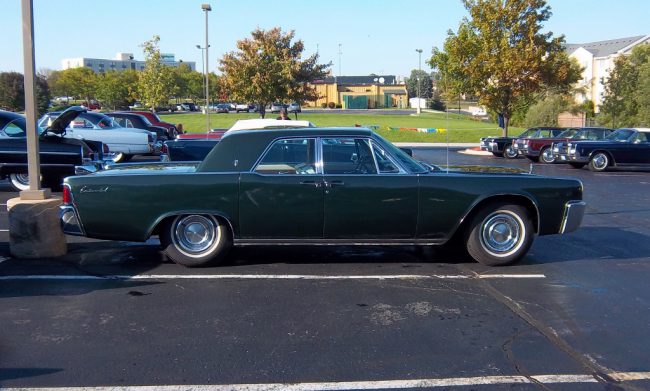
And the look was deftly maintained throughout the decade. These new Sixties Continentals looked nothing like prior Lincolns, and especially unlike the enormous 1958-60 models. Sounds a lot like 2017, when the new Continental appeared, doesn’t it? But I digress.
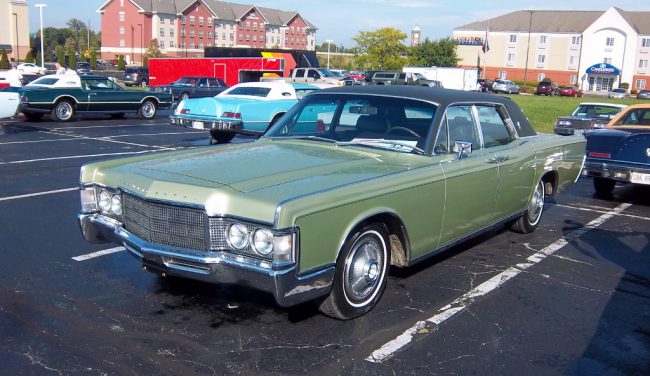
Updates in 1964 and 1966 enlarged the Connie and reverted to flat glass for more interior room, but the overall classic look remained. But by 1969, the Continental was getting a little long in the tooth, and new designs from Cadillac in 1967 and Imperial in 1969 were beginning to make the Lincoln look a bit behind the times. It was time for something new.
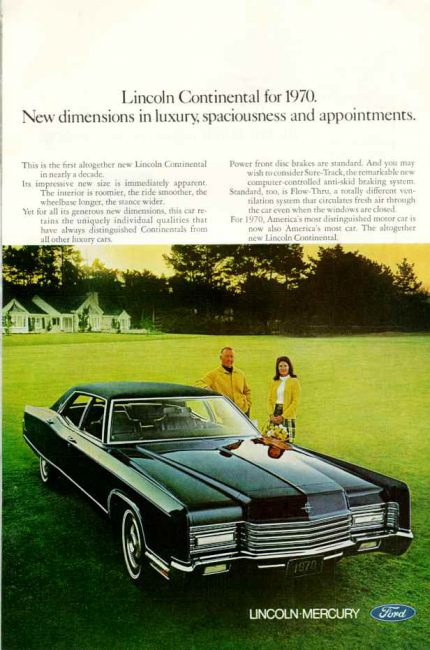
The 1970 Lincoln Continental really was all new. True, the 460 CID V8 and Select-Shift automatic transmission carried over, but other than that, not much else did. And it was a really good looking luxury car in 1970. Right with the times. With all the early ’70s expected luxury car features: hidden headlamps, concealed windshield wipes, smooth flanks and fender skirts.
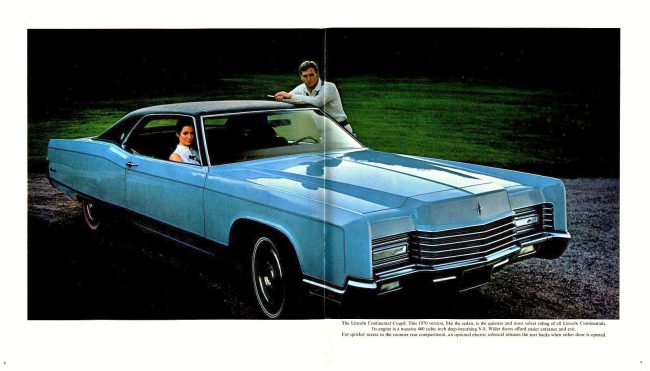
Models were limited, as in 1968-69, to a four-door pillared sedan and a two-door pillarless coupe. Cadillac had an impressive lineup, with multiple models and even a factory-built limousine, but not Lincoln. There were but three models: the Continental Mark III, Lincoln Continental sedan and Lincoln Continental Coupé.
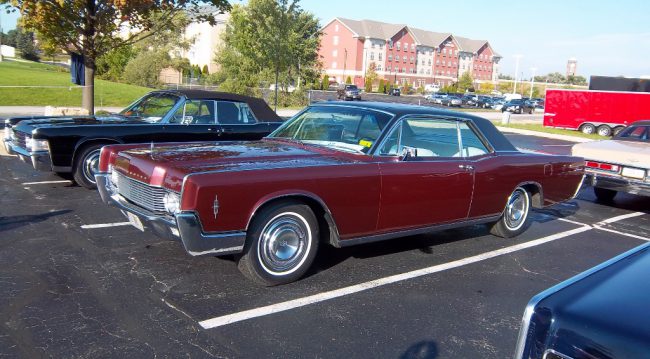
The two-door Lincoln had briefly disappeared from 1961-65, but returned for the 1966 model year. Although once the Continental Mark III appeared as a very early 1969 model, the two door Lincoln Continental became much less popular.
Of course, the big news to many Lincoln owners was the conventionally-hinged rear doors on the sedan. Ye gods! No more center-opening doors! So, why did Ford remove what was becoming a Lincoln trademark?
According to reports at the time of the ’70 debut, many Lincoln owners could either take them or leave them, but surveys indicated that Cadillac owners didn’t like them. So Lincoln abandoned the feature, in hopes of convincing Cadillac owners into a Continental instead of a Sedan de Ville.
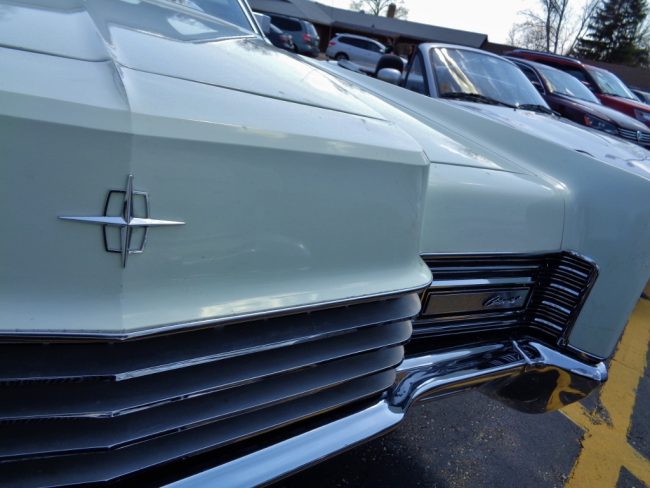
A prominent new feature was hidden headlamps. The Mercury Marquis actually got them before the Lincoln, for the 1969 model year. Concealed beneath a full-width and very Cord-like grille, they made for a very smooth nose. The 460 V8 came with four-barrel carburetion, 365 horsepower at 4600 rpm, and 500 ft-lb. of torque. Premium fuel was required. Most likely a non-issue for the well-heeled folks who bought these new.
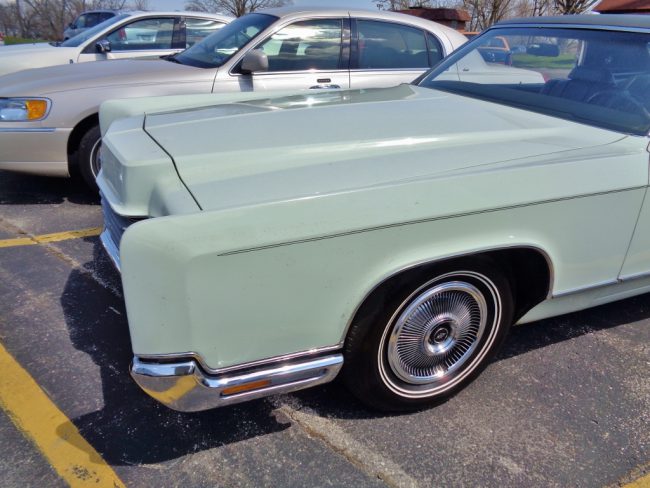
A 1970 Continental Coupé (yes, the official Lincoln literature put the accent on the ‘e’ of ‘coupe’) started at $5,976. Both the Continental sedan and the Coupé rode a 127-inch wheelbase, with an overall length of 225 inches. Curb weight was a not inconsiderable 4,860 pounds for the two door.
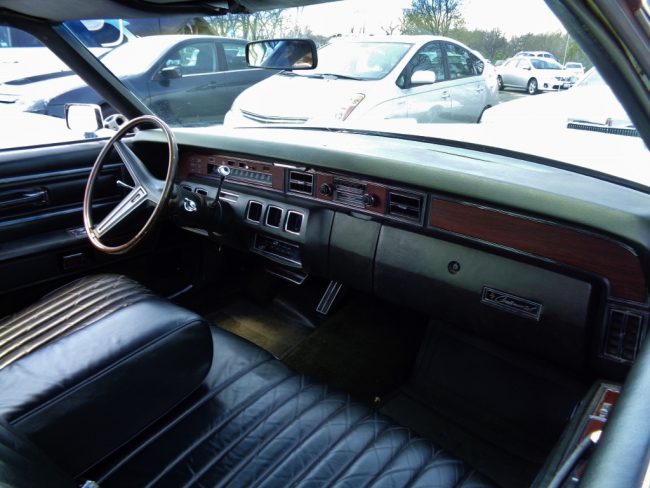
Of course, being a Lincoln, there were many standard features, and almost as many options. Choice was king in 1970! No limited color palette or option packages. Everything was a la carte, so you decided what you had to have and what you didn’t need.

Standard features included the expected power windows, power steering, power brakes (front disc, rear drum), automatic parking brake release, automatic transmission, fender skirts, cornering lamps and a two-way power seat.
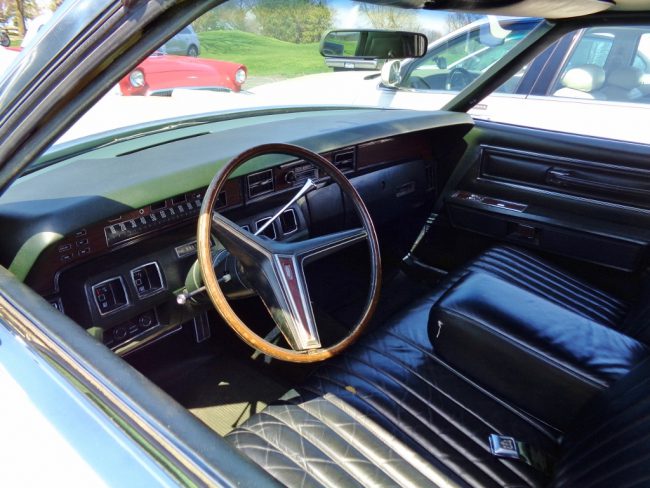
Options were many, but some of the more interesting items included Sure-Track, an early form of ABS, automatic headlamp dimmer, automatic temperature control, automatic ride control and the Cross Country ride package. Said package consisted of higher-load springs and heavy-duty shock absorbers. The more expected options of 6-way power seat, various AM/FM stereos and an 8-track player were also on the list.
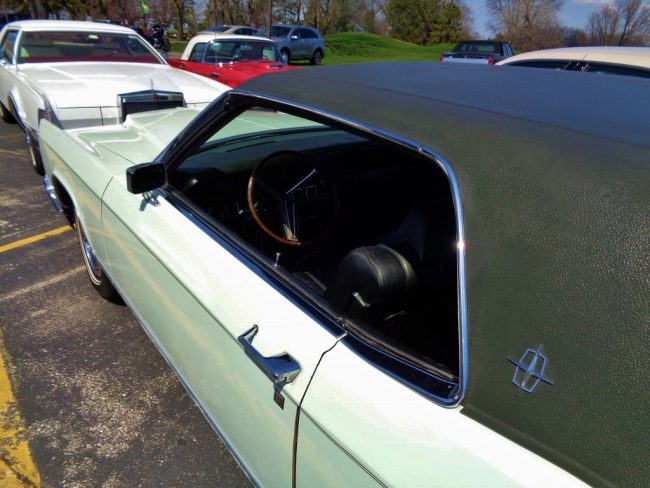
Being the top of the heap, of course Lincoln didn’t sell near as many cars as Mercury did its Marquis or Ford did LTDs. These weren’t cheap, after all. But the Coupé was especially rare to see, as only 9,073 were produced for the 1970 model year.
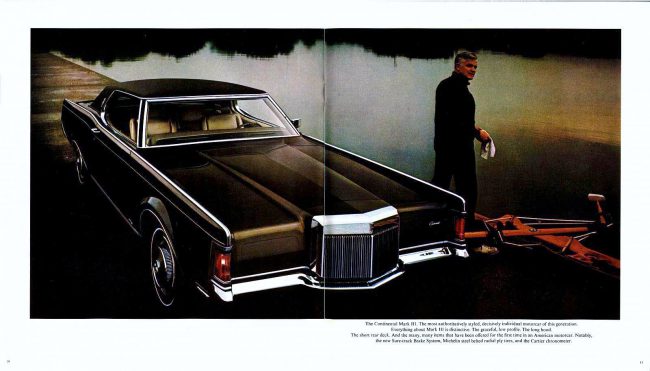
As previously mentioned, that had a lot to do with the Continental Mark III, which was far more popular for those shopping luxury coupes. 21,432 were built for 1970, despite a much higher price of $7,281-about $1200 more than the Continental Coupé.
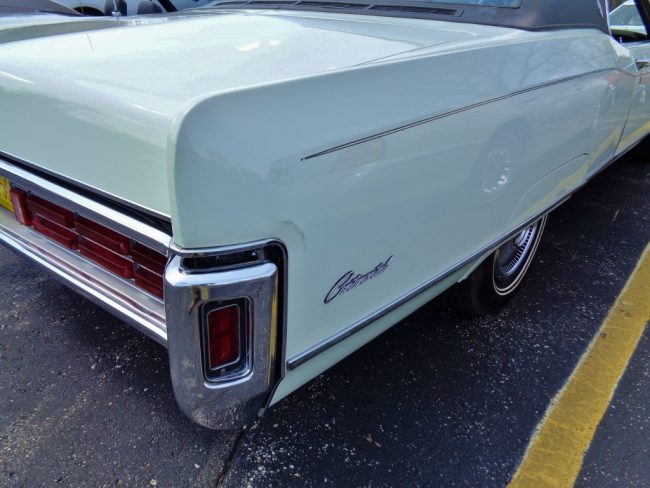
Our featured car today was spotted at the Lake Lawn Resort in Delavan, Wisconsin in April 2016 at an LCOC (Lincoln and Continental Owner’s Club) brunch I attended. It is owned by a fellow member and all-around nice guy, John McCarthy, and although I’d previously heard about the car, this was the first time I saw it in the metal.

It was beautiful in Diamond Green, with a dark green vinyl roof (one of five available top colors) and matching dark green leather interior.

He had found it online, in rough but solid shape, and slowly but surely brought it back to presentable condition. Original paint, top and interior too. It wasn’t perfect, but looked very good indeed!
John was nice enough to tell me the history of the car as I was putting this article together. Here is its story:
My 1970 Coupe was originally purchased by Mr. Henry Kroger and delivered through Hempstead Lincoln Mercury of Hempstead NY. Mr. Kroger not only had a residence in the New York city area, but also owned a home in Port Charlotte, Florida as well. Mr. Kroger was a graphic designer and ordered the car specifically, and had it delivered to New Jersey where he lived at the time. He did work for Estee Lauder and Alberto Culver and designed the Head & Shoulders logo. As soon as the car was delivered, it was sent down to Florida where it had spent almost all of its life. A Mr. Robert Oppold, a funeral director who lived in Waterloo IA also had a second home in Florida and lived right next to Mr. Kroger.
After many years of ownership, Mr. Kroger sold the car to his neighbor, Mr. Oppold and was later killed in a plane crash. Once this sad event took place, the car sat for many years in storage, henceforth the extremely low mileage, around 60,000 original miles.
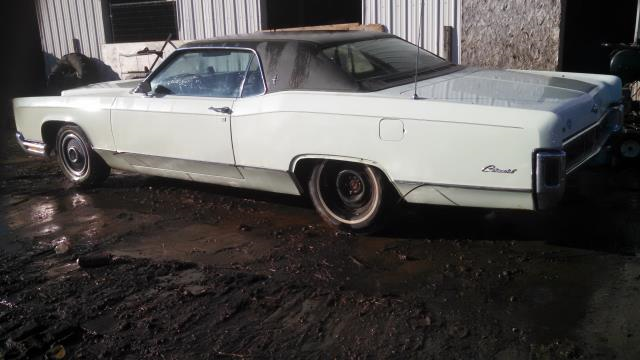
As purchased in 2015
I bought the car from the family that bought the car at Mr. Oppold’s estate auction in 2015. While the car was still very solid, it was terribly filthy and did not start or stop.
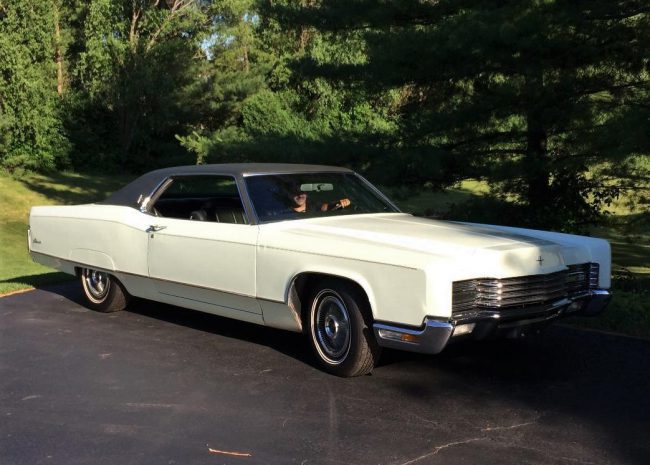
The car today
I am very proud of the car and think it is not only a rare car, but one of the most beautiful Lincolns of all time. Here are some pictures of the car when I picked it up and they way it looks today.
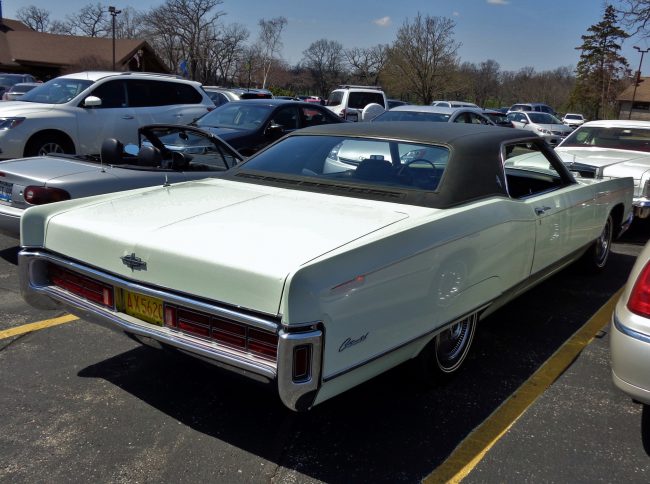
I parked my Town Car right next to it upon arrival at Lake Lawn Resort. And immediately leaped out of the car to ogle it. It was beautiful! You never see these any more, even at Lincoln club meets they are rare. Later that day, when everyone was about to head home, I followed John out to the car to get a few more pictures. Hey, I really liked this car! It was fantastic to hear it fire up and motor away too. That steady, bass blub-blub-blub-blub was heavenly. Like a road-going Chris-Craft!
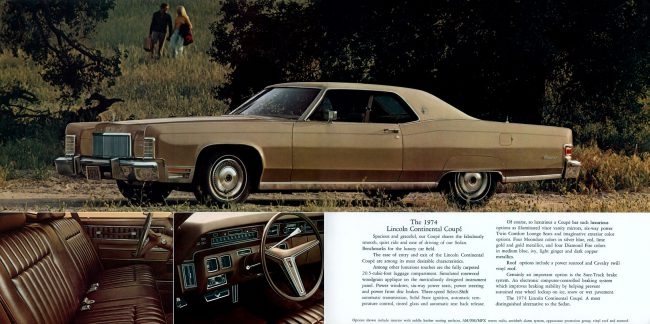
This style of Continental coupe would last through 1974. It never sold well compared to the Continental sedan. The Mark III and later Mark IV always stomped it in the coupe sales department. It had its own beauty though, and if you ever have the opportunity to see one at a show, I suggest you spend some time checking it out. You may never see one again!
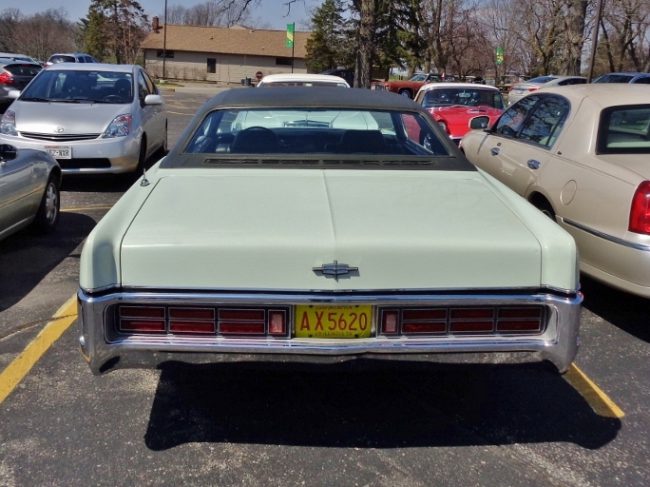


Thanks Tom for bringing this car to us. The previous generation is the one that gets all the kudos from import buyers but did little actual sales volume from such people. This was well engineered enough to lose weight while upsizing and going to the separate frame. The work Ford was doing getting their full size cars so quiet would become legendary.
Sure enough, going after a market that was actually available to Lincoln paid big dividends. This lesson sometimes seems lost today on luxury makers today. They strain to see the world as one market and forget to give the cars they design a sense of where they are from.
I loved that you included the biography of the original owner. A New York based, seriously wealthy, creative type is just not what the cynics would imagine a Town Coupe’ owner to be. He must have liked the car as well, having owned it so long.
There’s a ’77 Continental Town Coupé not far from me. I wrote about it, along with a few other Contnentals, at TTAC: http://www.thetruthaboutcars.com/2011/07/look-at-what-i-found-my-continental-summer/
“You may never see one again!” Boy, that’s the truth. I haven’t seen a Continental coupe since…Gosh, I guess since they were current. This is a beautiful example, with (original!) paint that looks good enough to eat. I enjoyed the story of its ownership, too. I’m glad Mr. McCarthy opted to revive the car and not restore it.
i had to look up the original head & shoulders design. it really is quite good:
http://www.retonthenet.co.uk/ekmps/shops/retonthenet/images/htf-vintage-bathroom-head-shoulders-lotion-glass-shampoo-bottle-in-original-box-1970s-original-contents-hair-care-dandruff-5408-p.jpg
It looks very premium, as opposed to something you need because you have head shed.
Tom,
Another great article! The car and the owner are both terrific, John is our (LCOC) membership chairman and does a terrific job promoting both the club and the brand. The splendor of the car in the flesh is a mirror of the times. Keep pulling vintage Lincolns out of your proverbial hat
Fantastic writeup! There is a 1970 Continental sedan that has popped up for sale at Hershey the past few years, and I have spent a lot of time ogling it. If I was buying a luxoboat in 1970, I’d have had a hard time deciding between Lincoln and Imperial.
If my ship ever comes in I would love one of these Singerized.
That’s a well-preserved specimen; and an excellent history and background.
But I don’t share others’ enthusiasm for that generation.
Now, I may be wrong here…but did Lincoln abandon an exclusive body, in favor of a version of the full-size Merc body, which had become just a variant of the full-size Ford body? This was in the early days of Iacocca’s Badge-Engineering trend…and it would fit his plan just fine.
I have never driven or even ridden in a 1960s Lincoln. But on paper it seemed to tick off a high number of attributes, functional, style and exclusivity:
–Unibody – back when that was relatively new. Chrysler was still struggling to make trouble-free examples.
–Suicide rear doors. Not only a nod to classic town carriages; but a Lincoln exclusive.
–The slab-sided, clean look. Mature buyers appreciate clean styling, more than younger drivers who wouldn’t be serious prospects.
–And the hydraulic wipers – hinged the reverse of how most American cars did it. Another thing that stands out – this is a LINCOLN, not a fer-chrissake Galaxie!
I blame Lido. Iacocca may have been just what Ford needed, after the disaster that was MacNamara; but his list of good ideas was a short one; and his list of bloopers, long.
I never got all the blaming of still with us Iacocca. The Mustang, even copied in Europe. The Mustang II bloat exorcised in time for gas lines. Granada, which brought luxury in an American style and price point at Euro size. The big 70s Fords that shamed RR and MB for quiet and smooth ride. At Chrysler fleshing out a basic K car to a full line with no resources. The minivan. Buying Jeep for peanuts.
The only serious flaw was in not using the profits of good times to reduce debt so that the bad times can be weathered. I know he pissed off a lot of people when he suggested that it might be good to buy American, but give the man his due. He was a giant.
Iacocca once said, of MacNamara, that his arrival at Ford was one of the best things to happen to the company. And that his departure in 1964 was also one of the best events to happen to Ford Motor Company.
The exact same thing could be said of Lee himself. BOTH at Ford, and at Chrysler.
My take is that his involvement with the Mustang was overrated. The idea of pursuing that new segment of the market was new; and his political skills in getting it through Henry II and Edward Lundy, the Finance gatekeeper…that was something only Iacocca could have done.
But the actual car, which hit all the right notes…was done by the Design guys.
And, after that…and an attempted second act with the Maverick…Lido lost his focus. Badge-engineering was the order of the day. It did reduce product-development costs; and Ford loyalists translated that to record profits…a trend that didn’t last. Lido was sacked just in time to save his reputation – I would posit that if he’d stayed three more years at Ford, he’d have the same sullied reputation that Lynn Townsend has, today.
Likewise his arrival at Chrysler. What he did, nobody else around could POSSIBLY have done. It was literally an impossible task – pull Chrysler back from the brink. A combination of political skills, marketing savvy, and a strong team taken from Ford, underneath him, helped him change direction, and in record time.
Eight years later, Chrysler was again flailing – Act K had run its course. Lido didn’t know that buying what was left of AMC would revitalize the company – but it did. What Lido lacked in raw innovation, he more-than-made-up in naked luck.
But even that couldn’t change things forever. Eight years later, the Chrysler board was getting disgusted with his failure to either keep up the pace of the past or to step down. Angrily, he did – and left a big smelly pile behind him, passing on Bob Lutz in favor of the useless Robert Eaton.
No, I don’t think Iacocca-bashing is over the top. He was what he was; and he was in equal parts a builder and a wrecker.
Remember about his later days at Chrysler, the later successes of the Intrepid and Neon, and especially the Grand Cherokee and the 94 Ram trucks were approved and invested in by Iacocca. Not easy thing to do 90-92 when car sales were in the toilet and so much capacity was being made redundant by the Japanese transplants. Eaton fixed what Iacocca missed in building that fantastic cash horde, but only to have it plundered by Daimler.
The later years of Iacocca at Ford also require some reassessing. What car replaced for 79 was bigger than the 78. The Mustang was again well reimagined in a way that would see it thrive in the 80s hp wars. Remember the celebrated Don Peterson thought a 4 cylinder only Mazda was good enough to be a Mustang. Also the rehabbing of the pickups, a Ford bread and butter, was getting much more attention at Ford than even resource rich GM. I also wonder if the lucrative stretching of the older big Lincolns into 79 and the Panther era was Iacocca’s doing. What a great alternative they were providing once GM had shrunk all their offerings.
Like I said, his was a very, very mixed legacy.
How much Lido had to do with the Neon or the redone Dodge truck, I don’t know. I DO know that Eaton was at best a caretaker; and he engineered the “merger of equals” that in fact was a corporate rape of Chrysler by Daimler-Benz. Remember, as part of his pay package, Eaton had stock options on a huge block of Chrysler shares. He exercised those options, and recruited others, inside and outside, to turn options into cash tender.
And one of the first questions Jurgen Schrenck asked, once the papers were signed, was “When are you leaving, Herr Eaton?” Lutz, Daimler wanted…although Lutz, a former BMW man and a European, wanted nothing to do with the Stuttgart raiders.
I do not think that rape and destruction would have happened if Lutz or someone else were CEO of the company at the time. At the very least, a more-fair settlement to the shareholders would have been negotiated; and had Schrenck not seen the big pile of cash Chrysler had as booty – because it was protected and not part of any deal – the deal would probably not have been done.
Likewise, Ford, years earlier. The New Mustang…publicity shots before Lido was fired, showed him posing with prototypes. But, Pinto-izing the Mustang had been his idea, also. Which was the right move? For all the healthy sales, I think the II was a bad idea; and cheapened the name for years to come.
The 1980 Ford pickup was hardly revolutionary. It didn’t change the package; it didn’t offer increased room or utility. It did somewhat update styling; but I never did see the bang for the buck. Was it the right note? Sales say yes; but when the development costs were listed, Car and Driver said, “You spent all this on WHAT?”
I recall Peterson’s flirting with Mazda-izing the Mustang; but I wonder if wiser heads would have prevailed in any event. Every leader has flaws, Peterson included.
As to the Panther: That was a bastardized compromise. In the days of Lido’s fading star, Lundy and Finance found it great sport to block ALL product development. David Halberstam detailed the executive battle where the Panther was offered as an alternative to a front-wheel-drive full-size car…what later was scaled down a bit to become the Taurus. But Lee cautiously advocated the FWD model – until it was obvious Hank II was not going for it, that a deal had been struck with Lundy. Shrink the current full-size car, until all this “downsizing” foolishness went away.
Hal Sperlich was disgusted…first his Mini-Max was shot down, and then the FWD new car. And mostly, as the opening act in sacking him, since shortly thereafter Lee was ordered to fire Sperlich. And of course then getting fired himself.
No, that the Panther survived for 25 years was unbelievably-good luck. And that its primary market, in the end, police and taxi operators, had no other mainstream option.
Just chiming in here to say that the Pinto Mustang II was, in fact, the right car for the times and it was more entertaining to drive in stock trim than the very low-power mid-Seventies second-gen Camaros.
Since I am having fun monday morning quarterbacking Iacocca’s decisions from 40 years ago lets do some more. A bigger FWD Taurus styled to look like Fords Euro offerings with a transverse Essex V6 as the single engine would have been a complete disaster in 1980. Both engine and transmission sucked and Ford would have had nothing when big RWD took off again in 83. Hal Sperlish would have been safe at Chrysler, he was there before Iacocca.
Imagine the Mustang II soldiering on through 1980 to be replaced by the name on the Escort EXP.
With Lutz, would Chrysler have built the cash horde? I doubt it with Lutz’s predilection to vanity cars. That would have kept Daimler away but would it have survived the 2001 downturn.
On the pickups, what did GM or Chrysler offer new in 1980, nothing.
We’ve probably beaten this horse into protoplasm; but I’ll pick up the challenge. First, remember, Iacocca was guardedly FOR the FWD program – his heart wasn’t in it but his man Sperlech supported it vigorously. But in those days, Henry despised his chain of command and would just make private decisions with Edward Lundy beforehand. What the Executive meetings were, were kabuki theater.
So, Lido saw the signal and backed off. And the Panther got the go-ahead.
It wasn’t market research or any nod or feel for the consumer. It was the LOW COST. The same low cost that let Ford turn the shopworn Torino into the Thunderbird. The bean counters held sway in those years; and Lundy was an expert, primarily at flattering Hank II.
The Panther models didn’t do especially well in their early years, if you’ll recall. Ford, for a brief time, was losing money as fast as Chrysler had a few years earlier. Nor was the Panther, even in its last years, anywhere NEAR the car the 1977 B-body GM models were, even in their FIRST year.
Since the Chrysler Ks were selling in the early 80s, perhaps a Taurus-like car released earlier would have gotten some of those sales. Perhaps, not…alternative reality is hard to argue.
As for the Chrysler war-chest: That was Lido’s build-up; one of his good ideas; Eaton had nothing to do with it. With his shopping Chrysler around, with all that money STILL in the bank, it showed what a naif he was.
Would Lutz have blown it? I doubt it; but we’ll never know. The end result for the stockholders would have been much the same. THEY never got it. DaimlerChrysler LOST value on that move; the shares of the new company worth less in the market than Daimler-Benz previously. The money was taken and squandered by Stuttgart.
Mustang II: Jack’s opinion notwithstanding, I hold the II a dud. Fun to drive? Probably. I had an early Pinto, and it, too, was fun to drive.
The original Mustang wasn’t really fun to drive. It was IMAGE. It was a rebodied Falcon. Imagine a kit-car on a VW Type 1 platform, mass-produced. THAT was the original Mustang.
Putting it on the Pinto chassis, where things were scaled down and there was much-less wiggle-room to change dimensions…didn’t work. I think of the Mustang II, I think of Charlie’s Angels getting out of the one they had.
Lee did have marketing instincts and saw to promote a reversal there. The Fox chassis was ideal for his purpose and, as Lundy would demand, didn’t cost much. Would the Escort have made it in there, instead of whatever current compact did? No, I think if the Fox hadn’t been launched, if the Granada soldiered on (a colossal disaster) the Torino would have been, not the Tbird, but the Mustang. As the Mercury side made it the Cougar.
It’s impossible to know. Like I said…it’s equal parts, good and not-good. Lido does illustrate the wisdom of rotating top management…they run out of good ideas, sometimes fast, but bad ideas are endless.
Well, the 1961 Continental was a heavily updated 1961 Thunderbird. So I don’t think it’s any worse to base the ’70 off of a Marquis than it was to base the ’61 off of a T-Bird. And Cadillacs were always derived from various and sundry B- and C-body GM cars. The whole of the car is more important than its components.
Pingback: 1971 Lincoln Continental - I Have A History With These - Riverside Green
Coupe production figures were not 9,073, but 3,073 for 1970.